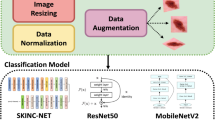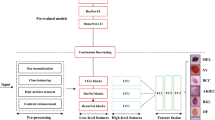Abstract
This paper presents a novel approach classifying benign and malignant skin lesions based on dermoscopy images using a deep learning (DL) framework. We present a dual deep neural network (DDNN) to solve the problem of classification accuracy (ACC) that varies from class to class, which happens when different feature sets work better for different classes. This DDNN comprises two deep neural networks (DNN) designed to extract and characterize lesions, utilizing two distinct handcrafted feature sets: phase congruency features and (PC) Gabor features (GA). PC is known for its resilience to illumination and contrast variations, and GA captures high-frequency directional information in localized regions surrounding the lesion. The DDNN outputs of these two-trained networks are aggregated, employing a novel likelihood-based add-and-compare decision (LACD) in the output layer. With the utilization of training data, this proposed method generates additional discriminative features that aid in the classification of malignant and benign. To evaluate the effectiveness of our approach, ablation studies and experiments were conducted using skin cancer images from the ISIC archive, achieving a normalised ACC of 87.76% for ISIC2016 and 84.25% for ISIC2017. The performance of our method is also compared with existing skin lesion classification methods.












Similar content being viewed by others
Data availability
Data sharing not applicable to this article as no datasets were generated or analyzed during the current study.
References
Liu X, Hou S, Liu S, Ding W, Zhang Y (2023) Attention-based multimodal glioma segmentation with multi-attention layers for small-intensity dissimilarity. J King Saud Univ - Comput Inf Sci 35(4):183–195. https://doi.org/10.1016/j.jksuci.2023.03.011
Liu S, Huang S, Wang S, Muhammad K, Bellavista P, Del Ser J (2023) August). Visual tracking in complex scenes: A location fusion mechanism based on the combination of multiple visual cognition flows. Inf Fusion 96:281–296. https://doi.org/10.1016/j.inffus.2023.02.005
Wang S, Huang S, Liu S, Bi Y (2023) Not just select samples, but exploration: Genetic programming aided remote sensing target detection under deep learning. Appl Soft Comput 145:110570. https://doi.org/10.1016/j.asoc.2023.110570
Janney JB, Roslin S (2018) Classification of melanoma from Dermoscopic data using machine learning techniques. Multimed Tools Appl 79(5–6):3713–3728. https://doi.org/10.1007/s11042-018-6927-z
Nie Y, Sommella P, Carratu M, Ferro M, O’Nils M, Lundgren J (2022) Recent advances in diagnosis of skin lesions using dermoscopic images based on deep learning. IEEE Access 10:95716–95747. https://doi.org/10.1109/access.2022.3199613
Talavera-Martínez L, Bibiloni P, Giacaman A, Taberner R, Hernando LJDP, González-Hidalgo M (2022) A novel approach for skin lesion symmetry classification with a deep learning model. Comput Biol Med 145:105450. https://doi.org/10.1016/j.compbiomed.2022.105450
Khan MA, Akram T, Zhang YD, Sharif M (2021) Attributes based skin lesion detection and recognition: a mask RCNN and transfer learning-based deep learning framework. Pattern Recogn Lett 143:58–66. https://doi.org/10.1016/j.patrec.2020.12.015
Iqbal I, Younus M, Walayat K, Kakar MU, Ma J (2021) Automated multi-class classification of skin lesions through deep convolutional neural network with dermoscopic images. Comput Med Imaging Graph 88:101843. https://doi.org/10.1016/j.compmedimag.2020.101843
Zhou Q, Shi Y, Xu Z, Qu R, Xu G (2020) Classifying melanoma skin lesions using convolutional spiking neural networks with unsupervised STDP learning rule. IEEE Access 8:101309–101319. https://doi.org/10.1109/access.2020.2998098
Rasel MA, Obaidellah UH, Kareem SA (2022) Convolutional neural network-based skin lesion classification with variable nonlinear activation functions. IEEE Access 10:83398–83414. https://doi.org/10.1109/access.2022.3196911
Wei L, Ding K, Hu H (2020) Automatic skin cancer detection in dermoscopy images based on ensemble lightweight deep learning network. IEEE Access 8:99633–99647. https://doi.org/10.1109/access.2020.2997710
Sharma AK, Tiwari S, Aggarwal G, Goenka N, Kumar A, Chakrabarti P, Chakrabarti T, Gono R, Leonowicz Z, Jasinski M (2022) Dermatologist-Level classification of skin cancer using cascaded ensembling of convolutional neural network and handcrafted features based deep neural network. IEEE Access 10:17920–17932. https://doi.org/10.1109/access.2022.3149824
Xie F, Fan H, Li Y, Jiang Z, Meng R, Bovik A (2017) Melanoma classification on dermoscopy images using a neural network ensemble model. IEEE Trans Med Imaging 36(3):849–858. https://doi.org/10.1109/tmi.2016.2633551
Zhuang D, Chen K, Chang JM (2022) June). CS-AF: A cost-sensitive multi-classifier active fusion framework for skin lesion classification. Neurocomputing 491:206–216. https://doi.org/10.1016/j.neucom.2022.03.042
Liu J, Chen A, Zhou G, Chen W, Peng N, Yan N (2021) Dermatoscopic image melanoma recognition based on CFLDnet fusion network. Multimed Tools Appl. https://doi.org/10.1007/s11042-021-10920-1
Bakkouri I, Afdel K (2019) Computer-aided diagnosis (CAD) system based on multi-layer feature fusion network for skin lesion recognition in dermoscopy images. Multimed Tools Appl 79(29–30):20483–20518. https://doi.org/10.1007/s11042-019-07988-1
Ding S, Wu Z, Zheng Y, Liu Z, Yang X, Yang X, Yuan G, Xie J (2021) Deep attention branch networks for skin lesion classification. Comput Methods Programs Biomed 212:106447. https://doi.org/10.1016/j.cmpb.2021.106447
Wei Z, Li Q, Song H (2022) Dual attention based network for skin lesion classification with auxiliary learning. Biomed Signal Process Control 74:103549. https://doi.org/10.1016/j.bspc.2022.103549
He X, Tan EL, Bi H, Zhang X, Zhao S, Lei B (2022) Fully transformer network for skin lesion analysis. Medical Image Anal 77:102357. https://doi.org/10.1016/j.media.2022.102357
Yu Z, Nguyen J, Nguyen TD, Kelly J, Mclean C, Bonnington P, Zhang L, Mar V, Ge Z (2022) Early melanoma diagnosis with sequential dermoscopic images. IEEE Trans Med Imaging 41(3):633–646. https://doi.org/10.1109/tmi.2021.3120091
Tang P, Yan X, Nan Y, Xiang S, Krammer S, Lasser T (2022) FusionM4Net: A multi-stage multi-modal learning algorithm for multi-label skin lesion classification. Med Image Anal 76:102307. https://doi.org/10.1016/j.media.2021.102307
Hsu BWY, Tseng VS (2022) Hierarchy-aware contrastive learning with late fusion for skin lesion classification. Comput Methods Programs Biomed 216:106666. https://doi.org/10.1016/j.cmpb.2022.106666
Wang X, Jiang X, Ding H, Zhao Y, Liu J (2021) Knowledge-aware deep framework for collaborative skin lesion segmentation and melanoma recognition. Pattern Recogn 120:108075. https://doi.org/10.1016/j.patcog.2021.108075
Alam MJ, Mohammad MS, Hossain MAF, Showmik IA, Raihan MS, Ahmed S, Mahmud TI (2022) S2C-DeLeNet: A parameter transfer based segmentation-classification integration for detecting skin cancer lesions from dermoscopic images. Comput Biol Med 150:106148. https://doi.org/10.1016/j.compbiomed.2022.106148
FoahomGouabou AC, Iguernaissi R, Damoiseaux JL, Moudafi A, Merad D (2022) End-to-end decoupled training: a robust deep learning method for long-tailed classification of dermoscopic images for skin lesion classification. Electronics 11(20):3275. https://doi.org/10.3390/electronics11203275
Hasan MK, Roy S, Mondal C, Alam MA, Elahi MTE, Dutta A, Uddinraju ST, Jawad MT, Ahmad M (2021) Dermo-DOCTOR: A framework for concurrent skin lesion detection and recognition using a deep convolutional neural network with end-to-end dual encoders. Biomed Signal Process Control 68:102661. https://doi.org/10.1016/j.bspc.2021.102661
Zafar K, Gilani SO, Waris A, Ahmed A, Jamil M, Khan MN, SohailKashif A (2020) Skin lesion segmentation from dermoscopic images using convolutional neural network. Sensors 20(6):1601. https://doi.org/10.3390/s20061601
Khan MA, Zhang YD, Sharif M, Akram T (2021) Pixels to classes: intelligent learning framework for multiclass skin lesion localization and classification. Comput Electr Eng 90:106956. https://doi.org/10.1016/j.compeleceng.2020.106956
Yu Z, Jiang F, Zhou F, He X, Ni D, Chen S, Wang T, Lei B (2020) Convolutional descriptors aggregation via cross-net for skin lesion recognition. Appl Soft Comput 92:106281. https://doi.org/10.1016/j.asoc.2020.106281
Yu Z, Jiang X, Zhou F, Qin J, Ni D, Chen S, Lei B, Wang T (2019) Melanoma recognition in dermoscopy images via aggregated deep convolutional features. IEEE Trans Biomed Eng 66(4):1006–1016. https://doi.org/10.1109/tbme.2018.2866166
Wang D, Pang N, Wang Y, Zhao H (2021) Unlabeled skin lesion classification by self-supervised topology clustering network. Biomed Signal Process Control 66:102428. https://doi.org/10.1016/j.bspc.2021.102428
Cassidy B, Kendrick C, Brodzicki A, Jaworek-Korjakowska J, Yap MH (2022) Analysis of the ISIC image datasets: Usage, benchmarks and recommendations. Med Image Anal 75:102305. https://doi.org/10.1016/j.media.2021.102305
Author information
Authors and Affiliations
Corresponding author
Ethics declarations
Conflict of interest
The authors certify that they have NO affiliations with or involvement in any organization or entity with any financial interest (such as honoraria; educational grants; participation in speakers’ bureaus; membership, employment, consultancies, stock ownership, or other equity interest; and expert testimony or patent-licensing arrangements), or non-financial interest (such as personal or professional relationships, affiliations, knowledge or beliefs) in the subject matter or materials discussed in this manuscript.
Additional information
Publisher's Note
Springer Nature remains neutral with regard to jurisdictional claims in published maps and institutional affiliations.
Rights and permissions
Springer Nature or its licensor (e.g. a society or other partner) holds exclusive rights to this article under a publishing agreement with the author(s) or other rightsholder(s); author self-archiving of the accepted manuscript version of this article is solely governed by the terms of such publishing agreement and applicable law.
About this article
Cite this article
Anand, S., Sheeba, A. & Maha Tharshini, M.K. Relative likelihood based aggregated dual deep neural network for skin lesion recognition in dermoscopy images. Multimed Tools Appl 83, 60603–60626 (2024). https://doi.org/10.1007/s11042-023-17908-z
Received:
Revised:
Accepted:
Published:
Issue Date:
DOI: https://doi.org/10.1007/s11042-023-17908-z




